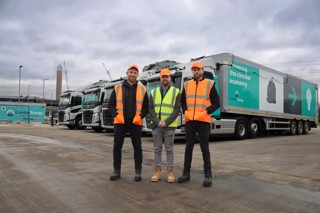Amey hit the fleet headlines last month after announcing plans to outsource its fleet management and funding to Hitachi Capital Vehicle Solutions in a six-year sole-supply deal. It joins an expanding group of large fleets that have handed operational responsibilities to a leasing provider.
Fleet and plant director Tom Lawless, the architect of the move, had spent eight months putting the contract together, presenting some 16 iterations of the proposal to the board before securing approval.
“It was a robust process,” he says pithily.
Hitachi was already well-known to the business, funding a number of its cars and vans over the previous five years. Amey had also inked a salary sacrifice contract with the company shortly before deciding to investigate a sole-supply outsourcing agreement.
The main business motivation was cost, although from a fleet perspective it will shift emphasis from “transact and execute to manage and improve”, says Lawless.
He explains: “We were getting in the way. Supply to demand contracts were coming through Amey Fleet and Plant and it was inefficient. Our role is to optimise the supply chain to ensure they meet our requirements on safety, cost and quality of build and to improve the level of service and end-to-end management of the assets.”
A large proportion of Amey’s business is with central and local government, Highways England, utilities companies and Network Rail, typically over five-to-nine year contracts.
Consequently, Lawless wanted to identify a partner with whom he could work for several years to deliver benefits across that period.
“Our marketplaces are tough with austerity measures in place but we are buoyant about our direction of travel,” he says.
“We have a healthy order bank of work but we have to get our cost base where it needs to be in order to be successful.”
There was, he adds, low-hanging fruit, such as extending car replacement cycles from three to four years, reducing the choice list to two brands (BMW/Mini and VW) and providing everyone who receives a company car allowance – whether car or cash – with a fuel card tied to their expenses to improve reporting of business mileage.
“Drivers have to report business mileage or the system assumes all their mileage is private. This quickly changed the culture around mileage reporting,” Lawless says.
However, the bigger wins came when assessing the cost of overheads and future investment to keep the fleet up to date
with the latest developments in technology and software. Amey wanted to plug into someone else’s investment in these areas, particularly when it came to its mission critical vehicles.
Hitachi’s software system platforms were already familiar and Amey was swayed by the company’s commitment to invest £15 million in ongoing developments over the next few years.
The outsource contract that was finally signed consisted of two key elements. The first involved a sale and leaseback of around 800 heavy goods vehicles and associated assets which took place at the end of March; the second, fleet management of all the Amey fleet including legacy supply chain, started in July.
“We had a significant owned fleet and we saw a tactical opportunity to dispose of some of these on a sale and leaseback,” says Lawless. “This gave us a cash benefit and meant we could also leverage a commercial deal with a partner to fulfil all of our demand requirements from cars to heavies and mission-critical vehicles.”
The decision to opt for a sole-supply deal with Hitachi required board sanction, not least because the company had a number of finance lease contracts with some of its banking partners.
The sale and leaseback proposition was a crucial element in clinching the deal as it showed Hitachi’s operational management capabilities, something the existing lenders/banks could not match.
The full extent of the savings is yet to be fully evaluated, although the cost of direct delivery versus in-house management alone will knock £2.5 million per year off
fleet overheads. Much of this is down to a significant reduction in headcount: Amey has more than halved its fleet team, from 85 to just under 40 people.
Additional savings will be identified during the contract period as part of a gain share mechanism. “If we reduce cost, both parties share the savings,” says Lawless. “It provides an incentive to identify new opportunities.”
Removing much of the day-to-day operational duties from the fleet team has freed up time to be more strategic, for example on data analysis. The team is also responsible for O-Licences, securing daily rental and transport management accountability.
“We are swimming in data but the pace of change was diverting us from doing the basics efficiently. We have enough management information to do things better and drive material change,” says Lawless.
“For example telemetry and the ‘internet of things’: we have 3,600 Masternaut units and we know manufacturers are moving towards prognosis with fault codes which will help us to plan our infrastructure and assets more efficiently to support Amey in the future.”
Amey is also trialling dash cams with internal-facing cameras, with the footage triaged with telematics data to prioritise actions rather than forcing the fleet team
to sift through reams of information. This
will target driver behaviour, speed up first notification of loss and resolve disputed or fraudulent claims.
However, the opportunities go far beyond driver behaviour and proactive vehicle maintenance; the data will also support Amey’s work with Highways England.
“We can even identify road issues if the data from our vehicle shows a reaction to a spot on the road,” Lawless explains. “True vehicle prognosis solutions are the golden egg for me as an operator.”
Lawless describes the fleet team as an inward-facing service provider and says he treats each business unit “as my customers”.
The 8,500-strong fleet, which ranges from cars to gritters and refuse collection, is divided across four divisions: highways (the biggest in fleet terms), utilities and facilities management, consulting and rail, and environmental services. The latter has the fewest number of vehicles but they are the most complex and it is the highest risk area of the group.
“Our role is to ensure the provision of services that are delivered in a cost-effective, operationally robust and safe manner,” Lawless says.
“We ensure fit-for-purpose vehicles that deliver the required outcomes and we also manage the supply chain. A lot of our focus is on how we fulfil that outcome, especially around the level of demand throughout a contract.”
Fluctuating demand means Amey has a sizeable short-term hire and flexi-rent fleet (“my top-up fleet”, says Lawless).
He adds: “Our decision on funding is influenced by the length of a contract and whether we can utilise the asset after that contract ends.”
Generally, everything above 5.5 tonnes is bought outright because the asset is depreciated over seven-to-nine years. Vans tend to be on a three-to-five year lease as long as the contract they are deployed to is secure.
“It’s the variable work where the short-term hire demand kicks in,” explains Lawless. “Around one-third of our fleet is on short-term or flexi; this is what helps us to flex the felt to cope with demand.”
While cost is a key fleet pillar, safety is also a priority. Lawless sits on the CLOCS (construction logistics and cyclist safety) panel and the business recently signed off a £3.5 million investment on safety-related equipment, which includes 360-degree cameras and cycle safety systems on its waste collection vehicles.
The cameras don’t just identify fixed obstacles like bollards; they have facial recognition software to alert the driver to the presence of a person next to their vehicle. “We are rolling this out now,” says Lawless. “It’s a big investment but it’s the right thing to do.”
He is also in the process of developing an operational road risk programme to identify high risk drivers by analysing telematics data, accident history and job profile. The system will advise on appropriate interventions and training, such as online modules, roadshows and proactive/reactive learning.
“We recognise the risks that our drivers face and that the management and support of them is appropriate. We are freeing up resource and energy to do more to support our organisation,” Lawless says.
The environment has also become a key part of the fleet function, not least because the type of tenders the business enters focus on the green agenda.
Amey’s car choice list is CO2-driven which has brought down average emissions from 123g/km to 109g/km over the past two years, with new orders averaging 103g/km. It has added plug-in and electric vehicles to the fleet, including the BMW i3 and Mitsubishi Outlander PHEV.
Internal priorities and external forces mean the Amey fleet is driven by all three pillars of modern-day fleet management: cost, safety and the environment. Lawless says his most pressing challenge is to continue managing the cost base to ensure the fleet allows Amey to make the right returns on its contracts.
“We also have to differentiate ourselves from our competitors,” he says. “We have to be well positioned to maximise all of the opportunities.”
Joiner turned fleet director
A joiner by trade, Tom Lawless started his career in fleet in 1990 as a buyer at Lex Vehicle Leasing because it allowed him the flexibility to embrace his hobby as a semi-competitive runner.
Up until 2007 he worked across the business, from the Lombard brokerage to the acquisitions team “and most jobs in between”. Lawless ran a number of large accounts, including the Ministry of Defence and Halifax fleets, before deciding to return to his joiner roots.
In 2010, he came back to fleet, waiving an opportunity to rejoin Lex (now Lex Autolease) to experience fleet from the perspective of the end user.
Lawless joined Amey, attracted by its heavy goods vehicles, initially as business development and operations director before being appointed fleet and plant director 12 months ago.
He is responsible for all road-going equipment and plant, consisting of some 8,500 assets.




















Login to comment
Comments
No comments have been made yet.